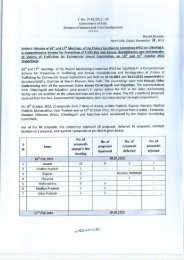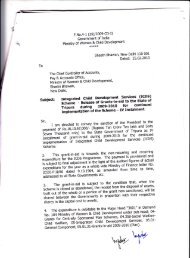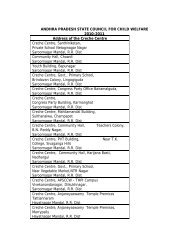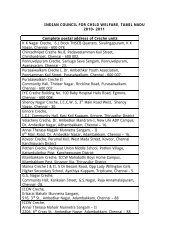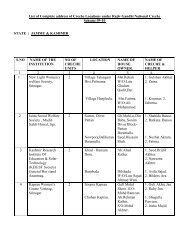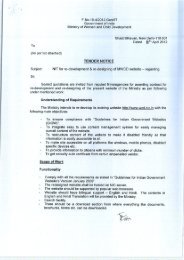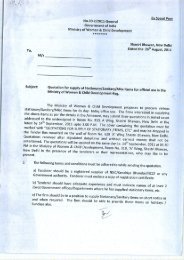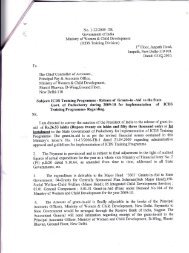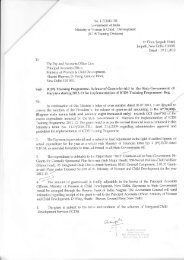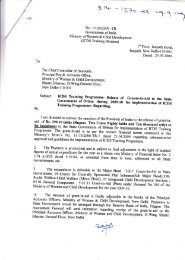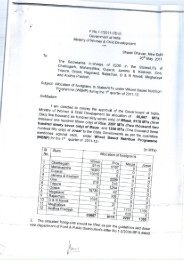COVER HINDI - Ministry of Women and Child Development
COVER HINDI - Ministry of Women and Child Development
COVER HINDI - Ministry of Women and Child Development
- TAGS
- hindi
- ministry
- wcd.nic.in
You also want an ePaper? Increase the reach of your titles
YUMPU automatically turns print PDFs into web optimized ePapers that Google loves.
<strong>Development</strong>; <strong>Child</strong> Welfare <strong>and</strong> Protection; Prevention<br />
<strong>of</strong> Trafficking, Girl <strong>Child</strong> & Gender Budgeting; <strong>and</strong> Plan,<br />
Research, Monitoring & Statistics. Besides Joint Secretary<br />
<strong>and</strong> Financial Adviser <strong>of</strong> the <strong>Ministry</strong> looks after the<br />
financial matter <strong>of</strong> the <strong>Ministry</strong>.<br />
1.7 The <strong>Ministry</strong> has 4 autonomous organizations viz.<br />
National Institute <strong>of</strong> Public Cooperation <strong>and</strong> <strong>Child</strong><br />
<strong>Development</strong> (NIPCCD), Rashtriya Mahila Kosh (RMK),<br />
Central Social Welfare Board (CSWB) <strong>and</strong> Central<br />
Adoption Resource Agency (CARA) working under its<br />
aegis. NIPCCD, RMK <strong>and</strong> CARA are societies registered<br />
under the Societies Registration Act, 1860. CSWB is a<br />
charitable company registered under section 25 <strong>of</strong> the<br />
Indian Companies Act, 1956. These organizations are fully<br />
funded by the Govt. <strong>of</strong> India <strong>and</strong> they assist the Department<br />
in its functions including implementation <strong>of</strong> some<br />
programmes/schemes. The National Commission for<br />
<strong>Women</strong> was constituted as a national apex statutory body<br />
in 1992 for protecting <strong>and</strong> safeguarding the rights <strong>of</strong><br />
women. The organization chart <strong>of</strong> the <strong>Ministry</strong> is at<br />
Annexure II.<br />
Thrust Areas, Policies, Plans <strong>of</strong> action,<br />
Legislations, <strong>and</strong> Programmes/ Schemes<br />
for advancement <strong>of</strong> women <strong>and</strong> children<br />
Improving Nutritional Status <strong>of</strong> <strong>Women</strong> <strong>and</strong> <strong>Child</strong>ren<br />
– ICDS, KSY <strong>and</strong> NPAG<br />
1.8 Although there has been a significant improvement<br />
in the nutritional levels <strong>of</strong> women <strong>and</strong> children during the<br />
last three decades, the present levels <strong>of</strong> malnutrition are<br />
still unacceptably high. In order to achieve sustainable<br />
improvement in the nutritional status <strong>of</strong> women <strong>and</strong><br />
children, it is necessary to recognize <strong>and</strong> address the silent<br />
emergency <strong>of</strong> malnutrition within the context <strong>of</strong> overall<br />
development policy. <strong>Women</strong>, especially in the reproductive<br />
age group, are particularly vulnerable to the risk <strong>of</strong><br />
maternal mortality <strong>and</strong> hence the <strong>Ministry</strong> has focused on<br />
inputs such as supplementary nutrition for pregnant women<br />
<strong>and</strong> lactating mothers, pre <strong>and</strong> post natal health care check<br />
up <strong>and</strong> health <strong>and</strong> nutrition education, through the ongoing<br />
Integrated <strong>Child</strong> <strong>Development</strong> Services (ICDS)<br />
programme. Under this programme, supplementary<br />
nutrition is given to children (0-6 years), pregnant <strong>and</strong><br />
lactating mothers <strong>and</strong> facilitate, immunization, health<br />
checkup, referral (through health set up) services, pre<br />
school non formal education (3-6 years children), nutrition<br />
<strong>and</strong> health education through the Anganwadis.<br />
1.9 The Kishori Shakti Yojana (KSY) <strong>and</strong> Nutrition<br />
Programme for Adolescent Girls (NPAG) are schemes<br />
which target undernourished adolescent girls <strong>and</strong> are<br />
implemented through the infrastructure <strong>of</strong> ICDS.<br />
1.10 The National Institute <strong>of</strong> Public Cooperation <strong>and</strong><br />
<strong>Child</strong> <strong>Development</strong> (NIPCCD) <strong>and</strong> other training centres<br />
in various parts <strong>of</strong> the country train the ICDS project<br />
<strong>of</strong>ficials on a continuing basis to enable them deliver the<br />
services in a very efficient manner. NIPCCD also conducts<br />
other training awareness programs <strong>and</strong> details are available<br />
in the chapter 8 <strong>of</strong> this report.<br />
1.11 The National Nutrition Policy adopted in 1993<br />
identified a series <strong>of</strong> actions in different sectors. In<br />
pursuance <strong>of</strong> that, the food <strong>and</strong> Nutrition Board <strong>of</strong> <strong>Ministry</strong><br />
<strong>of</strong> <strong>Women</strong> <strong>and</strong> <strong>Child</strong> <strong>Development</strong> has been undertaking<br />
a number <strong>of</strong> initiatives in the area <strong>of</strong> addressing infant<br />
<strong>and</strong> young child nutrition, nutrition monitoring etc.<br />
Ensuring Survival <strong>and</strong> Welfare <strong>of</strong> Girl<br />
<strong>Child</strong>, Prohibition <strong>of</strong> <strong>Child</strong> Marriage Bill<br />
1.12 The rising incidence <strong>of</strong> female foeticide <strong>and</strong><br />
infanticide, which has led to decline in the sex ratio from<br />
976 in 1961 to 927 in the year 2001 (for 0-6 years) is a<br />
reflection <strong>of</strong> society’s perception <strong>of</strong> the values <strong>and</strong> respect<br />
accorded to a girl child. The problem <strong>of</strong> child marriage<br />
needs to be tackled in order to reduce maternal mortality<br />
<strong>and</strong> infant mortality.<br />
1.13 Nation wide awareness <strong>and</strong> sensitization campaigns have<br />
been organized to educate the masses that the girl child is an<br />
asset <strong>and</strong> not a burden. A number <strong>of</strong> awareness programmes<br />
<strong>and</strong> sensitization programmes have been organized by the<br />
<strong>Ministry</strong> during 2006-07 to sensitize <strong>and</strong> generate awareness<br />
among different sections <strong>of</strong> societies <strong>and</strong> stakeholders about<br />
ill effects <strong>of</strong> female foeticide <strong>and</strong> infanticide. The <strong>Ministry</strong> is<br />
closely working with M/o Health & Family Welfare in<br />
implementing <strong>and</strong> monitoring “Preconception <strong>and</strong> Prenatal<br />
Diagnostic techniques Act, 1994”.<br />
4 Annual Report 2006-07



